Pilgrimage and tourist places in and around (near) Tirupati (Tirumala) (Venkatachalam hill) | Tourist places near Tirupati
Namaste friends, how are you doing today? Welcome to #BhagavanBhakthi website / blog.
Bhagavan Lord Sri Srinivasa (Venkatesha) (Venkateswara) (Balaji) (Krishna) (Vishnu) and Goddess Sri Lakshmi (Padmavati) blessings to you and your family!
In this website / blog, you will always learn about #Hinduism #Sanskrit language.
Also subscribe to my YouTube channel from this link #BhagavanBhakthi to view videos about #Hinduism #Sanskrit language.
Just before going to “Pilgrimage and tourist places in and around (near) Tirupati (Tirumala) (Venkatachalam hill) | Tourist places near Tirupati“, let us know a brief, basic and very important information.

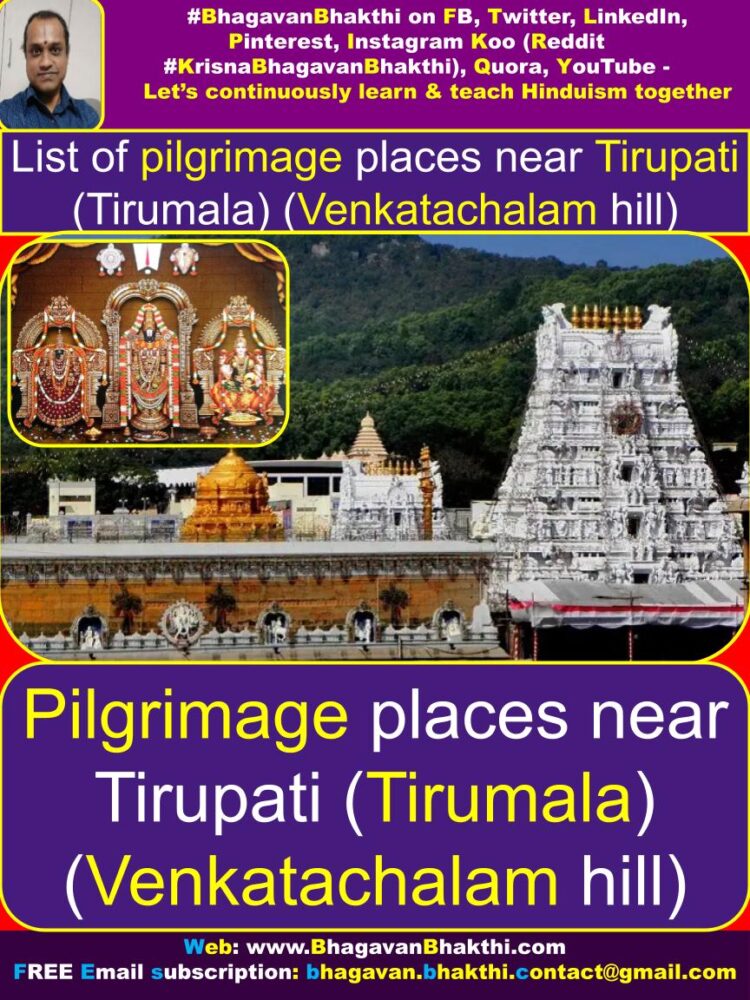
India is full of pilgrimage places. India (Bharat) is the most auspicious and divine nation on this earth. From north Kashmir to south Kanyakumari and from west Gujarat to east Arunachal Pradesh, our great country India is filled with various pilgrimage places.
Tirupati is the place which is been famous since ages. This is the same place where Lord Sri Vishnu in his avatar of Lord Sri Srinivasa (Venkatesha) (Venkateswara) (Balaji) came to earth to get marry with Goddess Sri Padmavati Devi.
To witness the most divine marriage, all the Devatas (Demigods) and Devis (Demigoddesses) had arrived including:
Goddess Sri Lakshmi Devi, Lord Sri Brahma Deva, Lord Sri Vayu Deva, Goddess Sri Sarasvati Devi, Goddess Sri Bharati Devi, Lord Sri Rudra Deva (Shiva), Goddess Sri Parvati Devi, Lord Sri Indra Deva, Lord Sri Kama Deva, Lord Sri Surya Deva, Lord Sri Chandra Deva, etc.
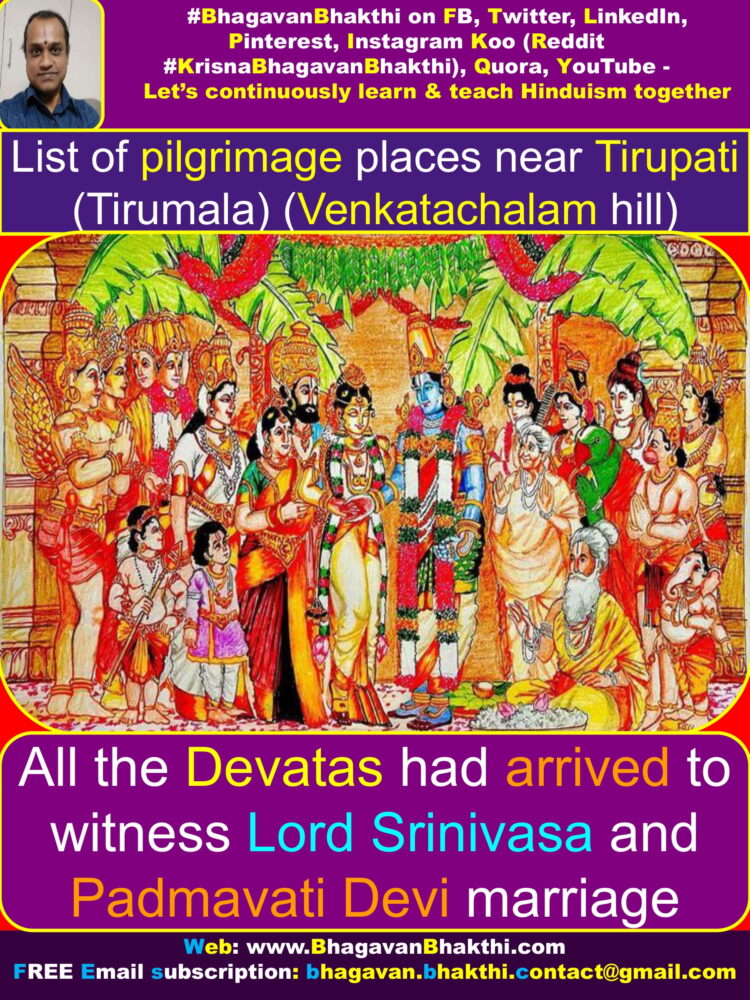
In this post (article) you can find the pilgrimage and tourist places in and around Tirupati (Tirumala) (Venkatachalam) as per today’s existence and also as per the Hindu Puranas.
First let us know the pilgrimage and tourist places in and around Tirupati (Tirumala) (Venkatachalam) as per today’s existing and later as per the Hindu Puranas (Texts) (Scriptures).
List of pilgrimage and tourist places in and around Tirupati (Tirumala) (Venkatachalam) is as given below:
Lord Sri Venkateswara Swamy temple : In Sanskrit Venkateswara is written as वेन्कटेश्वर (veṅkaṭēśvara). Other names of Lord Venkateswara are Lord Sri Srinivasa, Lord Sri Venkatesha, Lord Sri Balaji, Lord Sri Govinda, etc.
Lord Venkateswara is the direct avatar (incarnation) of Lord Sri Vishnu. Lord Venkateswara came down to earth to re-establish the Dharma and mainly to marry Goddess Sri Padmavati Devi who is an avatar of Goddess Sri Lakshmi Devi.
Lord Sri Vishnu had promised Goddess Vedavati Devi (earlier avatar of Padmavati Devi) that in the Kali Yuga, he will take the avatar of Lord Sri Venkateswara and will definitely marry her as per her wishes.
Different names of Tirumala Hills are – Venkatadri (Venkatachalam), Garudachalam (Garudri), Sheshachalam (Sheshadri), Vrushabhachalam (Vrushabhadri), Neelachalam (Neeladri), Narayanachalam (Narayanadri) and Anjanachlam (Anjanadri).
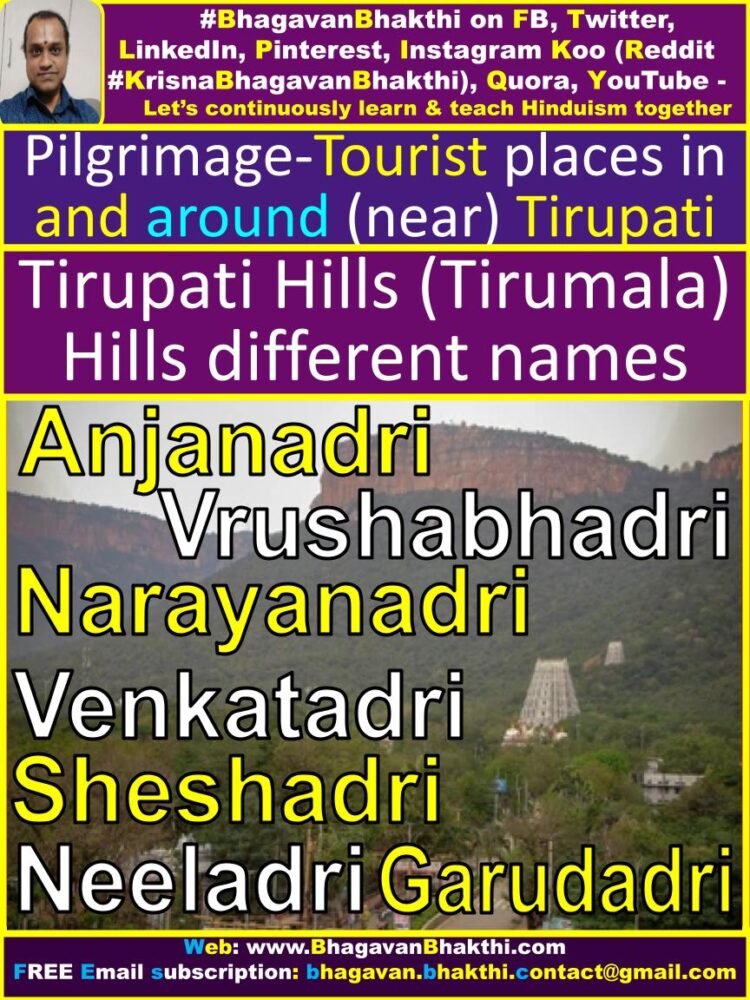
The Lord Sri Venkateswara temple is built in South Indian architecture and is believed to have been built in the period starting from 300 CE. Garbhagriha (Sanctum Sanctorum) is called as Ananda Nilayam.
Approximate distance from the main cities of India to Tirupati (Tirumala) hills is as given here : From Bengaluru it is 270 km, from Mumbai it is 1,180 km, from Chennai it is 158 km, from Thiruvananthapuram it is 889 km, from Hyderabad it is 581 km, from Nagpur it is 1098 km.
Similarly from Bhubaneswar it is 1,206 km, from Bhopal it is 1,447 km, from Gandhinagar (Gujarat) it is 1,741 km, from New Delhi it is 2,159 km, from Lucknow it is 1,870 km, from Ranchi it is 1,715 km, from Kolkata it is 1,648 km, from Jaipur it is 2,042 km and from Srinagar (J&K) it is 2,953 km.
Varadaraja Temple : There is a small shrine dedicated to Lord Sri Varadaraja (Lord Sri Vishnu form) in the vimana-pradakshinam to the left of Vendivakili (silver entrance) while entering the temple of Lord Sri Venkateswara. The date of installation of this deity is unknown. This deity is in sitting posture facing west.

Yoga Narasimha Temple : This temple is dedicated to Lord Sri Narasimha (an avatar of Lord Sri Vishnu) is at the north-east corner of the Vimana-Pradakshina at the Lord Sri Venkateswara complex.
Lord Sri Yoga-Narasimha is seen seated in a cross-legged posture bound by a yoga position and holding a conch (Panchajanya Shankha) and disc (Sudarshana Chakra) in the upper two hands and the lower two hands in the yoga mudra.
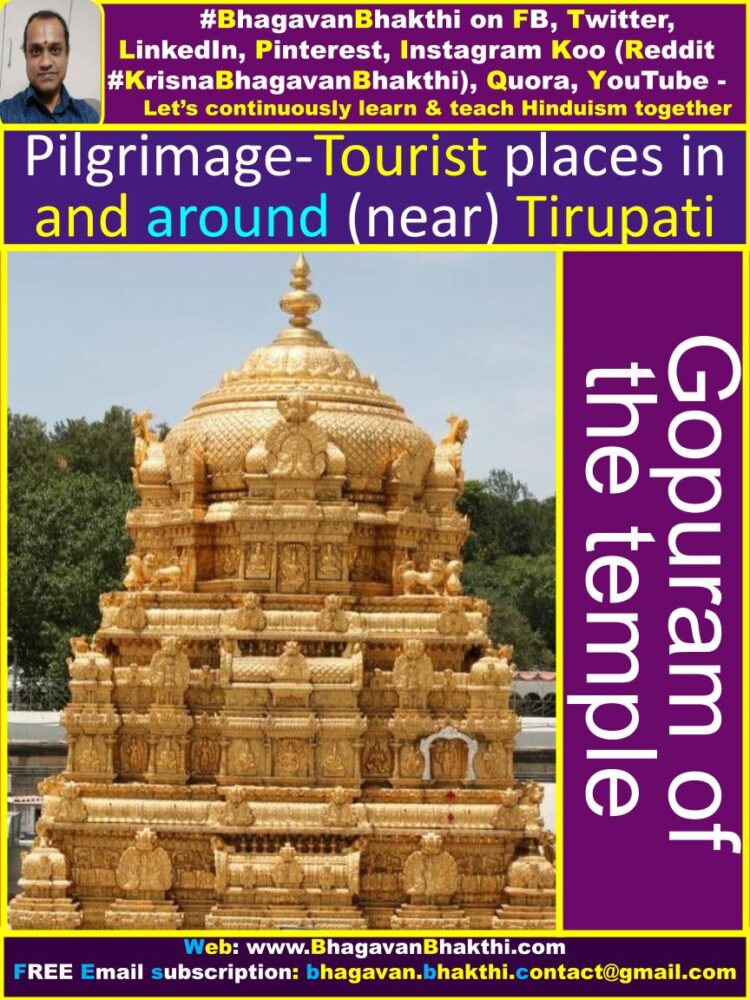
Garuthmantha Temple : A small temple dedicated to Lord Sri Garuda, the vehicle (mount) of Lord Sri Venkateswara, is located exactly opposite Jaya-Vijaya’s Bangaruvakili (Golden Entrance) inside Lord Sri Venkateswara complex.
This sub-temple is a part of Garudamantapa. Garuthmantha is six feet tall and faces west facing the main deity of Lord Sri Venkateswara inside the garbhagriha (Sanctum Sanctorum).

Bhuvaraha Swamy Temple : Bhuvaraha Swamy Temple is a temple dedicated to Lord Sri Varaha and Goddess Sri Bhudevi (Mother Earth). Lord Sri Varaha is an avatar of Lord Sri Vishnu. This temple is believed to be older than the main deity Lord Sri Venkateswara.
This temple is situated on the north bank of Swami Pushkarini inside the Lord Sri Venkateswara temple complex. According to tradition, the offering is first offered to Lord Sri Bhuvaraha before being offered to Lord Sri Venkateswara.
As per the ancient tradition, all devotees must have darshan of Lord Sri Bhuvaraha Swami first and then of Lord Sri Venkateswara.
This is because, the main owner of this place of Tirumala (Venkatadri) is Lord Sri Bhuvaraha Swamy and as per the request of Lord Sri Venkateswara, Lord Sri Bhuvaraha has given some space for Lord Sri Venkateswara.
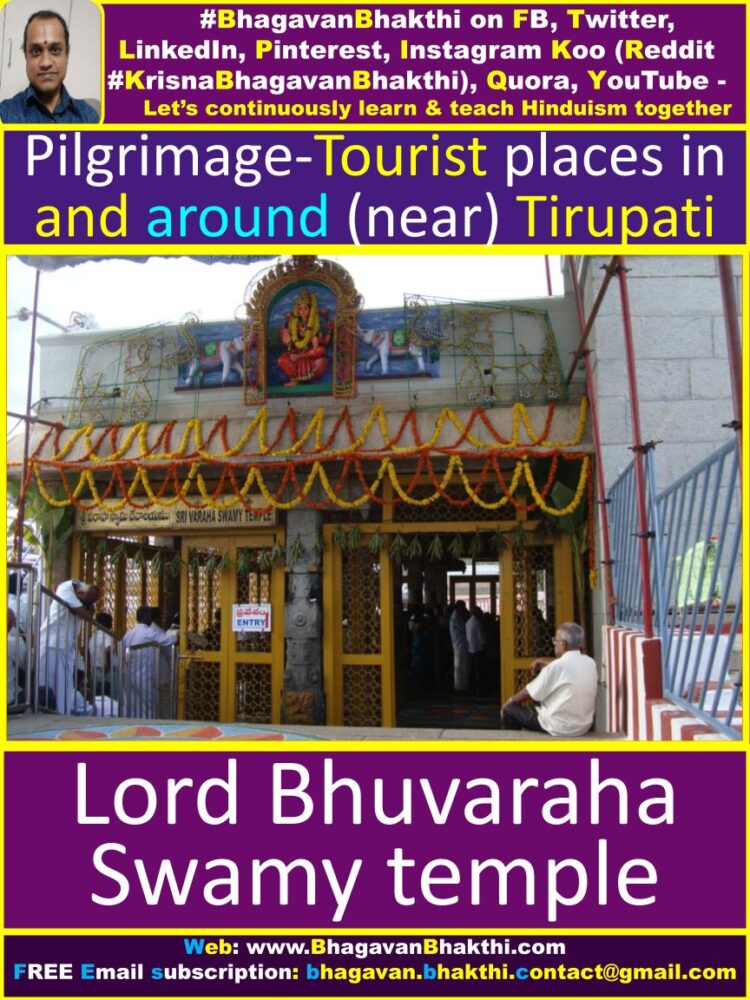
Bedi-Anjaneya Temple : Bedi-Anjaneya Temple is a sub-shrine dedicated to Lord Hanuman inside the Lord Sri Venkateswara temple complex.
This temple is opposite the Mahadwaram near the Akhilandam (coconut offering place). The god in this temple has both his hands handcuffed. In Telugu and Kannada ‘bedi’ means handcuffs.

Vakulamatha (Bakulamatha) Sannidhi : Vakulamatha sometimes also spelled as Bakulamatha is the mother of Lord Sri Venkateswara. There is a statue dedicated to her in the main temple in front of Varadaraja shrine inside the Lord Sri Venkateswara temple complex.
Vakulamatha deity is in a sitting posture. According to a legend, Vakulamatha administer the preparation of food to be given to her son Lord Sri Venkateswara. For this reason, a hole was made in the wall separating Vakulmatha’s sannidhi and Srivari potu (kitchen).
In the Earlier life this Vakulamatha was Yashoda during the Dwapara Yuga and the foster mother of Lord Sri Krishna.
Mother Yashoda didn’t see any marriage of Lord Sri Krishna and thus had asked a boon from Lord Sri Krishna that she will be seeing Lord Sri Venkateswara marriage in the Kali Yuga with Padmavati Devi.
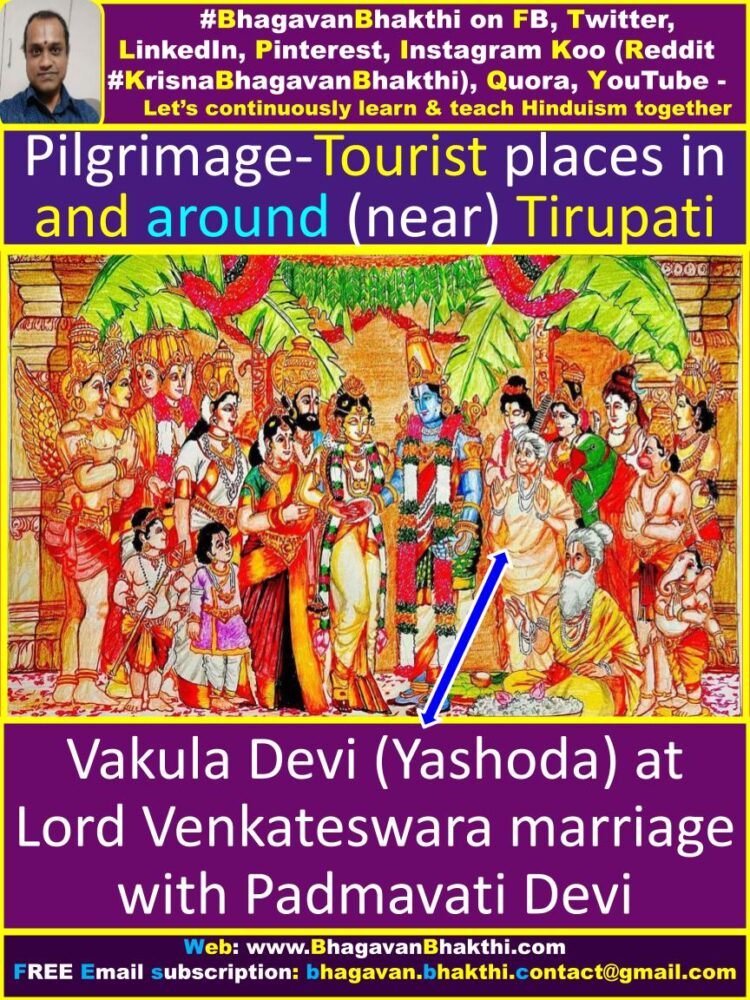
Kubera Sannidhi : Inside the Lord Sri Venkateswara temple complex, that is, at the Vimana Pradakshina there is a sub-shrine dedicated to Lord Kubera. The deity is on the right side of the sanctum sanctorum and faces south towards the main deity.
Lord Kubera is the one who has given loan to Lord Sri Venkateswara for his marriage with Goddess Sri Padmavati Devi. This loan has to be given back by Lord Sri Venkateswara to Lord Kubera before the end of Kali Yuga.
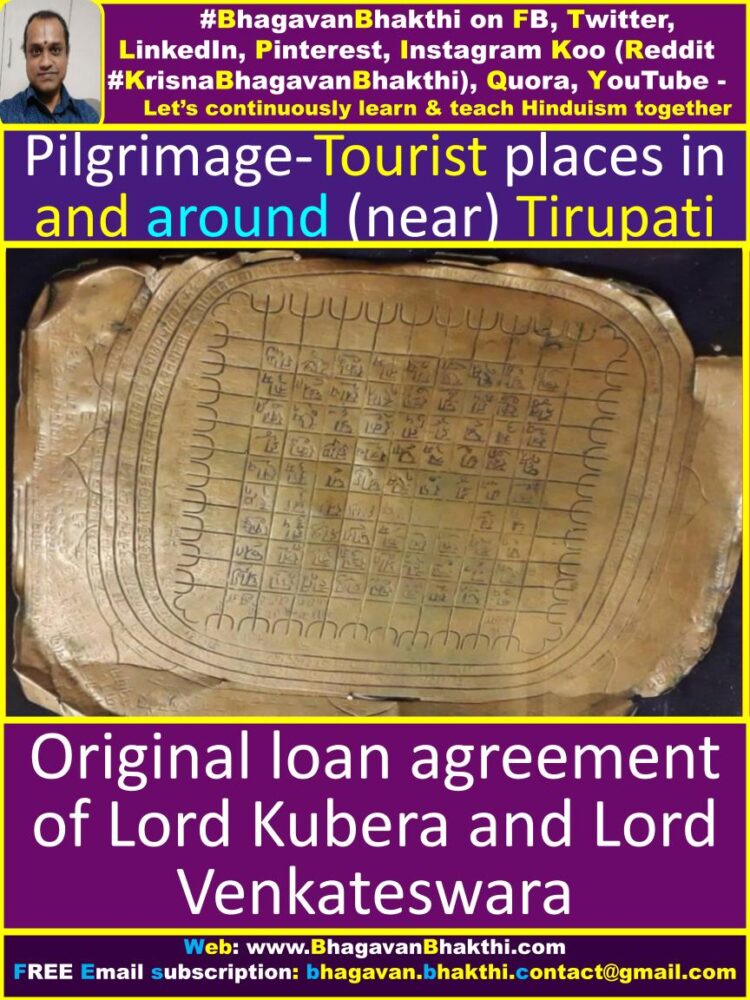
Ramanuja Temple : Sri Ramanuja or Sri Ramanujacharya Temple is located next to the north corridor of Vimana Pradakshinam at the Lord Sri Venkateswara temple complex. It is also known as Bhashyakara Sannidhi. This temple was built around 13th century.

King Sri Krishnadevaraya and his two wives : The Lord Sri Venkateswara temple acquired its present wealth and size with the donation of diamonds and gold by the Vijayanagara emperor Sri Krishnadevaraya, who belonged to present day Karnataka state.
This bronze statues of Sri Krishnadevaraya along with his two wives Tirumala Devi and Chinnamma Devi is located in Tirumala Temple complex in Pratima Mandapam and later this mandapa came to be known as Krishnadevaraya Mandapa.
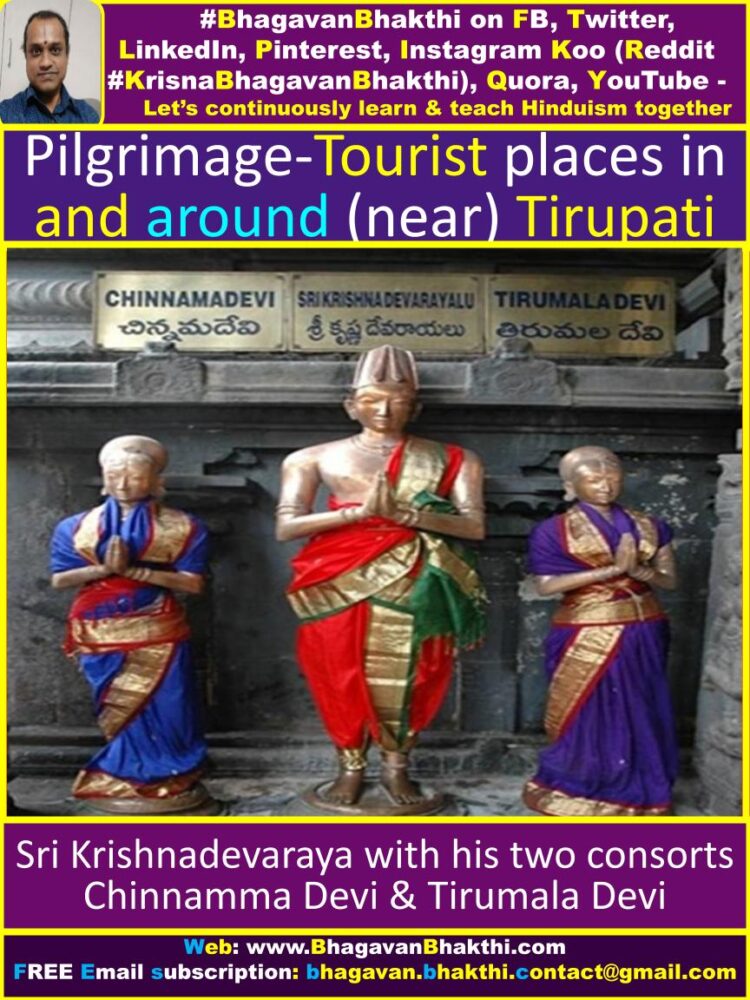
Sri Govindaraja Swamy Temple, Tirupati : Lord Sri Govindaraja Swamy Temple is an ancient Hindu Vaishnava temple located in the heart of Tirupati city in Tirupati district of Andhra Pradesh, India.
The temple was built in the 12th century and consecrated in 1130 by Saint Sri Ramanujacharya. This temple is one of the earliest structures in Tirupati and one of the largest temple complexes in Tirupati district.
Before Sri Govindarajaswamy (Lord Sri Vishnu’s form) was installed as the prelate, Lord Sri Parthasarathy Swamy was the presiding deity of the temple. Kotturu village at the foothills of Tirumala hills was moved to the vicinity of Sri Govindarajaswamy temple, which was later merged into Tirupati city.

Sri Govindarajaswamy Temple is a large complex with many sub-temples inside the same temple complex. Lord Sri Parthasarathy Temple, Kalyana Venkateswara Temple are the most prominent among the sub-shrines.
There are also temples of Pundarikavalli, Andal, Chakratalwar, Alwars, Lakshmi Narayana Swamy, Anjaneya, Tirumala Nambi, Bhashyakarla Swamy (Saint Sri Ramanujacharya). The distance between the Tirumala foot hills and Sri Govindarajaswamy temple is about 1.3 km.
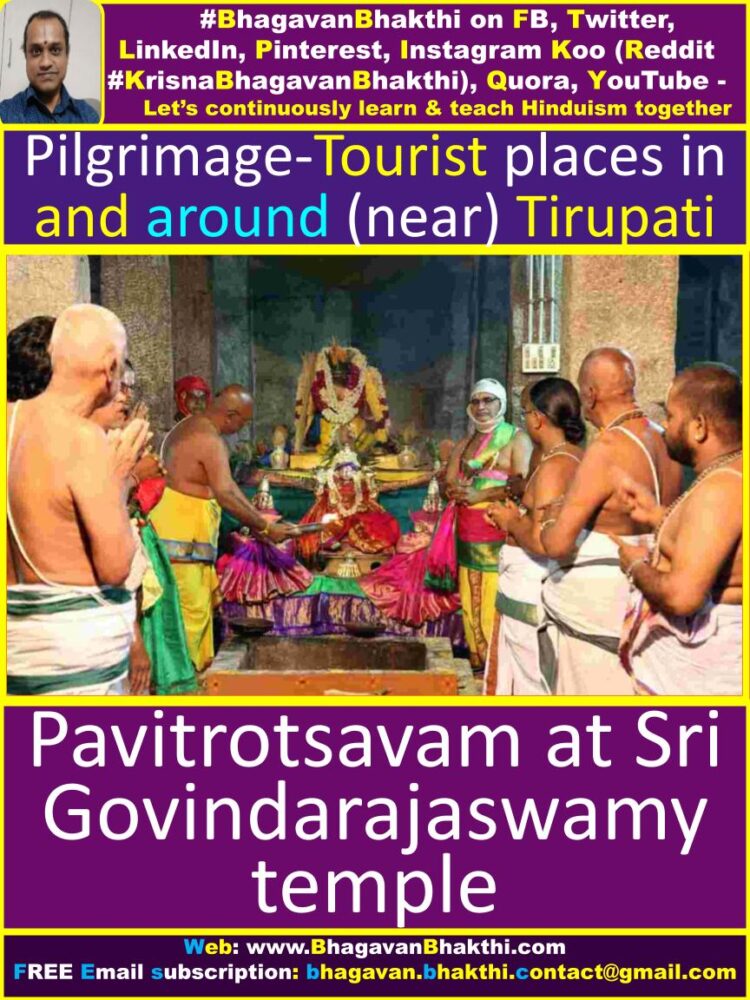
Srivari Padala Mandapam, Tirupati : Srivari Padala Mantapam is a temple dedicated to Lord Sri Venkateswara in Alipiri. The presiding deity is referred to Padala Venkateswara Swami.
According to legend, Lord Sri Venkateswara (Balaji), after getting ‘Ekantha Seva’ at Tirumala, meets his consort Goddess Sri Padmavati Devi at Tiruchanur, through this hill via the Alipiri steps and will leave his footwear at this place and hence this place came to be known as “Padala Mantapam” (In Telugu padalu means foot).
Devotees going on a pilgrimage to Tirumala, first offer prayers here carrying “Srivari Padukalu” (believed to be a representation of the footwear worn by Lord Sri Venkateswara) on their heads.
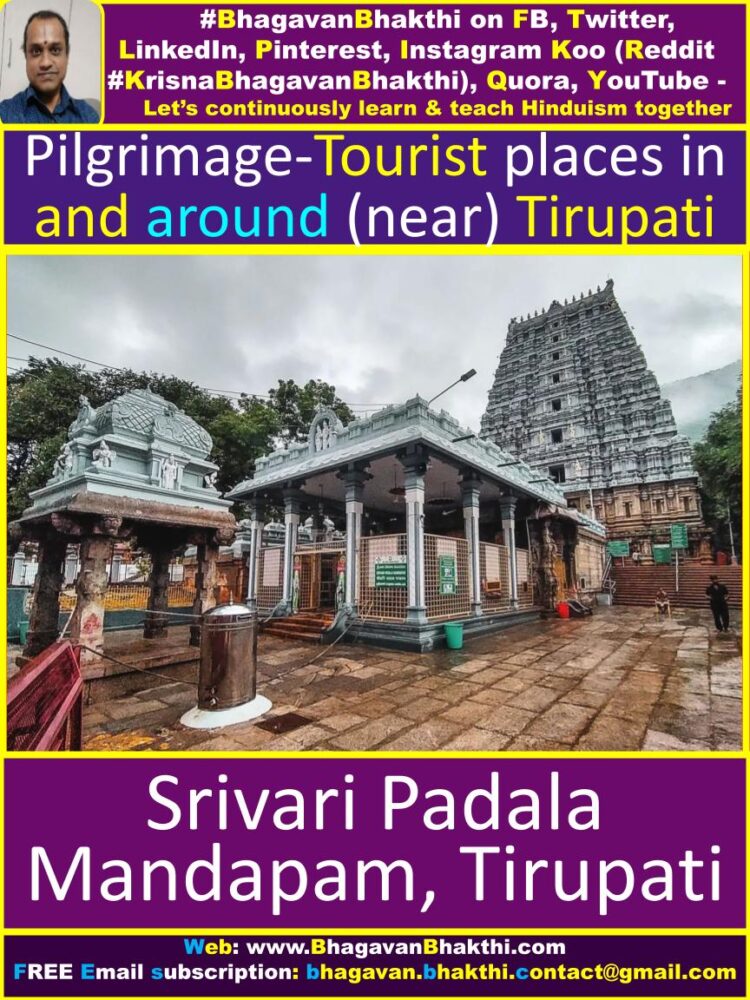
Sri Lakshmi Narayana Swamy Temple : To the east of the Padala Mandapam is a sub-temple dedicated to Lord Sri Lakshmi Narayana (Lord Sri Vishnu) in the Alipiri Padala Mandapam temple complex. The temple entrance and deity face west. It has a sub-shrine dedicated to Andal.
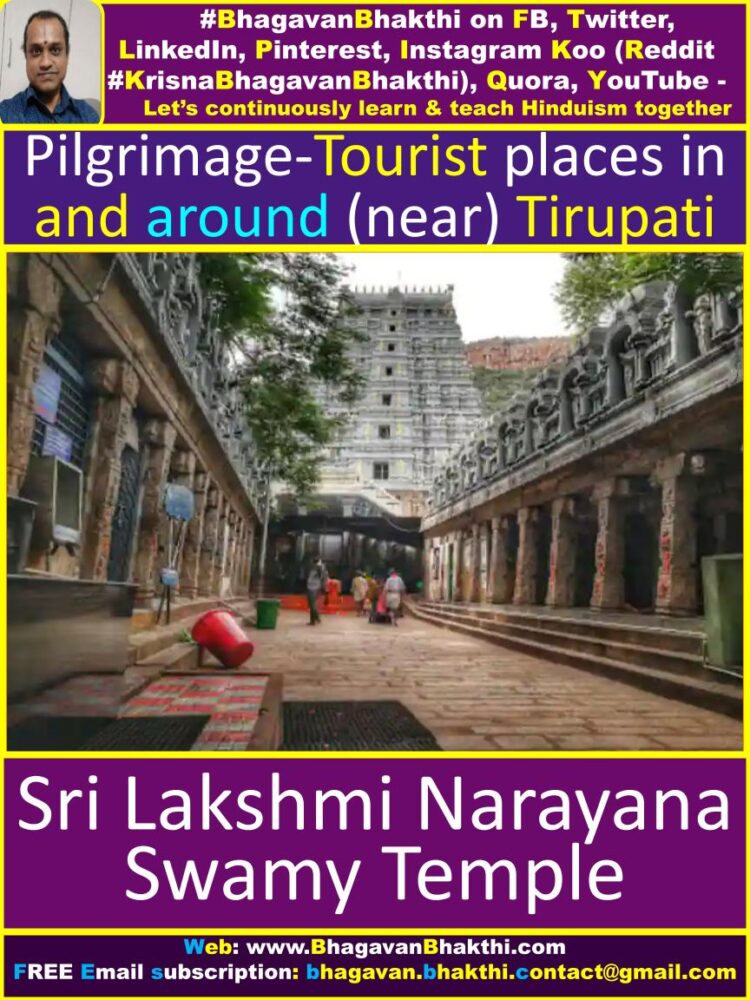
Sri Vinayaka Swamy Temple : There is also a temple dedicated to Lord Ganesha in the Alipiri Padala Mantapam temple complex on the 2nd Ghat road from Tirupati to Tirumala. Devotees going by road offer prayers at this temple before starting the Tirumala pilgrimage.
Sri Padmavathi Ammavari Temple, Tirupati : Padmavathi Temple is a temple dedicated to Goddess Sri Padmavati Devi or Alamelumanga, consort of Lord Sri Venkateswara (Balaji). This temple is located in Tiruchanur, Tirupati district, Andhra Pradesh, India.
As per the legends Goddess Sri Lakshmi Devi took the avatar of Padmavathi or Alamelu or Alamelumanga or Alamelumangamma to the King Akasha Raja who was the ruler of this region and got married to Sri Lord Venkateswara.
Lord Sri Venkateswara saw Goddess Sri Lakshmi Devi on a red lotus flower (Padma in Sanskrit) at Alamelu Mangapuram after his twelve years of deep penance.
According to tradition, the Mother Goddess Sri Lakshmi Devi appears in a golden lotus in the sacred Pushkarini called Padmasarovaram and thus she got the name Padmavathi, that is, someone who was seen on a Padma (lotus) flower.
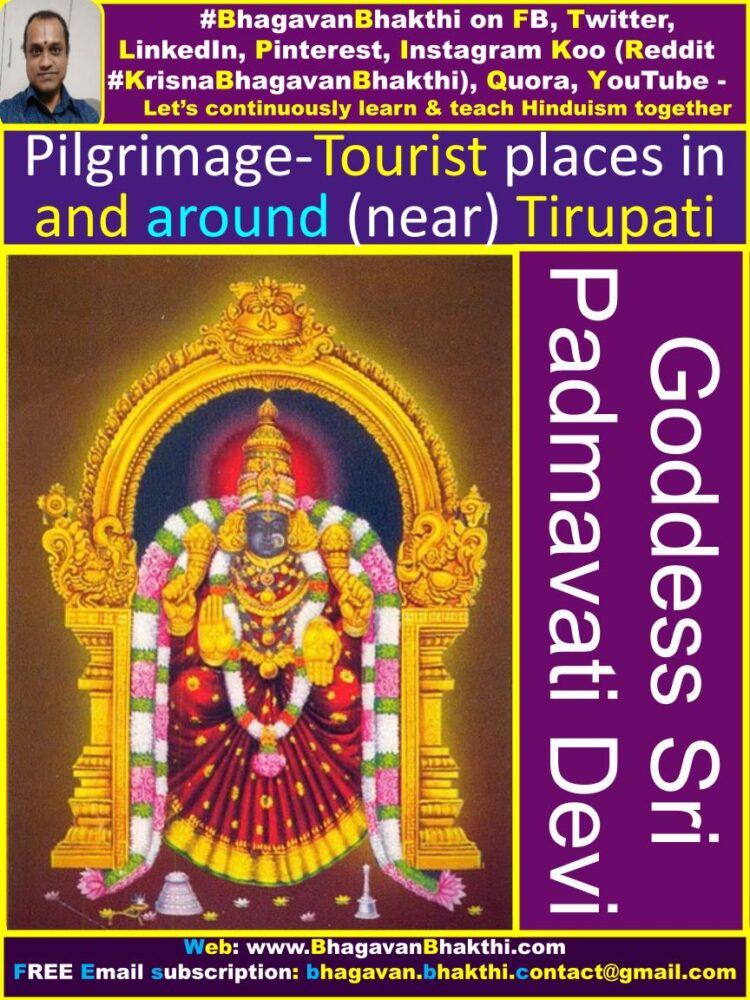
According to Venkatachala Mahatyam, Lord Suryanarayana (Sun God) caused the lotus to bloom in full glory. A temple dedicated to Lord Sri Suryanarayana is situated on the eastern side of Padmasarovaram Pushkarini.
The Padma Purana gives a vivid account of the arrival of Goddess Padmavati and her subsequent marriage to Lord Sri Srinivasa. Goddess Sri Padmavati Devi appeared in the Uttarashadha Nakshatra on Shukla Paksha Panchami in the month of Kartika.
Sri Krishna Swamy Temple and Sri Sundararaja Swamy Temple are sub-temples within the Padmavati Temple complex. Sri Krishna Swamy Temple is the oldest of the temples within the temple complex. According to evidence this temple came into existence in 1221 AD.
Sri Sundararajaswamy Temple came into existence in the 16th century and is dedicated to Sri Varadaraja Swamy and his consorts Sridevi and Bhudevi. Opposite the Padmasarovaram (temple pond) there is also a temple dedicated to Suryanarayana. The deity of this temple is believed to have been installed by Lord Sri Venkateswara.
The distance between Tirumala foothills (Alipiri) to Sri Padmavathi Ammavari Temple, Tirupati, Tiruchanur is about 10 km.
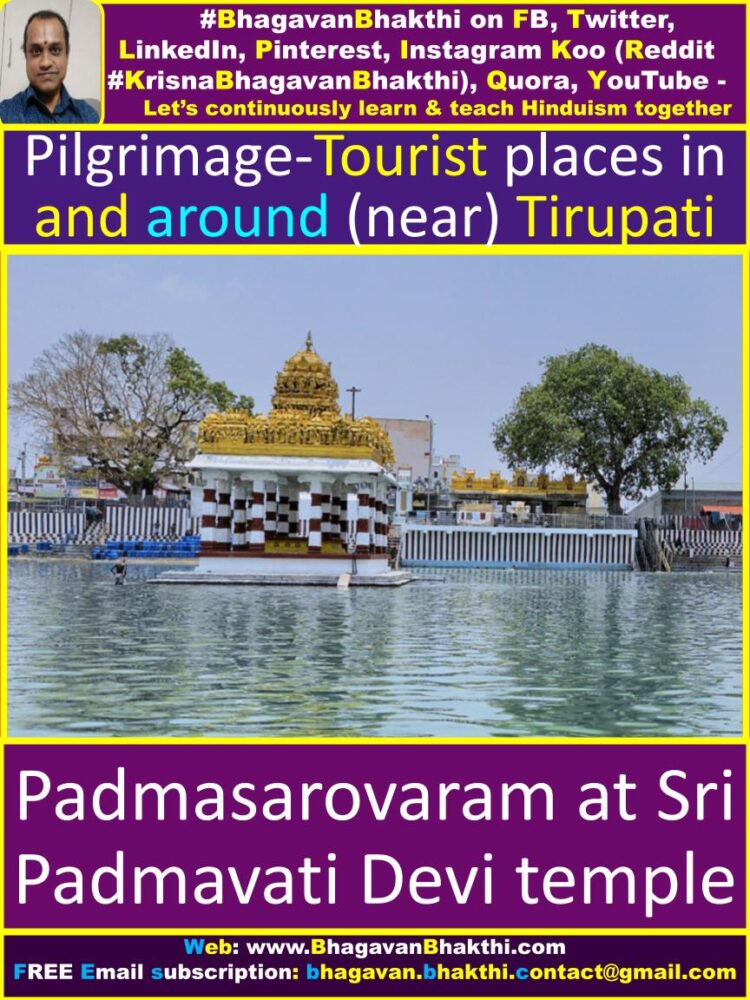
Sri Kapileswara Swamy Temple (Kapila Theertham), Tirupati : Kapila Theertham is a famous Lord Shiva temple and a Theertham (pond) at the foothills of Tirumala Hill in Tirupati district, Andhra Pradesh, India.
This deity is believed to have been installed by Kapila Muni and hence Lord Shiva here is known as Kapileshwara.
According to the legend of the temple the sage Kapila did penance on Lord Shiva at this place and pleased with the devotion of the sage, Lord Shiva and Goddess Sri Parvati Devi presented themselves in this particular place.
Lord Shiva Linga in this place is self-manifested. Sage Kapila is believed to have emerged from a Bilam (cave) to earth at this Pushkarini (theertham) (pond).
There are many sub-temples are present within the main temple premises. Kamakshi-consort of Lord Shiva, Lord Vinayaka, Lord Subrahmanya, Agastishwara, Rukmini Satyabhama along with Lord Sri Krishna’s temples are some of them. Kapila Theertham is less than 1 km.
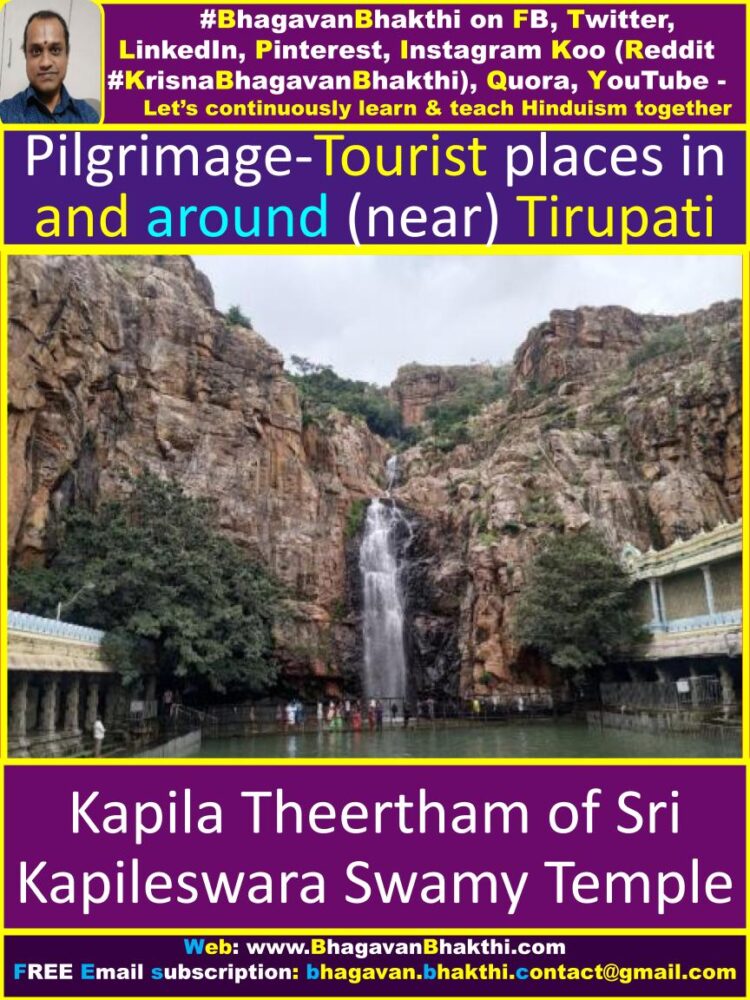
Kalyana Venkateswara Temple, Srinivasamangapuram, Tirupati : Sri Kalyana Venkateswara Swamy Temple adjacent to Tirumala Temple is considered highly sacred. Those who cannot go to Tirumala can have the darshan of Lord Sri Kalyana Venkateswara Swamy to fulfill their wishes.
As the name suggests, this temple has significance for newlyweds. Newly-married first offer prayers at this temple as it is the place where Sri Kalyana Venkateswara Swami stayed with Goddess Sri Padmavati Devi for six months after their marriage.
The presiding deity of the temple is Lord Sri Venkateswara himself, who is known as Sri Kalyana Venkateswara in this place. The deity is in a standing posture facing east with four hands, the left two hands holding a varada mudra and a chakra and the right two hands holding a kati mudra and the other holding a Shankha.
After celebrating his marriage with Goddess Sri Padmavati Devi, Lord Venkateswara didn’t returned to the Tirumala hills. But he visited Sage Agastya’s ashram to seek blessings.

At the behest of Sage Agastya, Lord Venkateswara stayed with his consort Goddess Sri Padmavati Devi in his humble hermitage, which is now a famous temple of Lord Sri Kalyana Venkateswara. Divya couple stayed here for six months.
On his way back to the Tirumala temple, Lord Venkateswara blessed the place with two boons – 1. Newlyweds and elderly people who cannot visit Tirumala can avail the same benefits by visiting Sri Kalyana Venkateswara Swamy Temple.
2. A devotee who participates in the Kalyanotsavam and ties the ‘Kada’ on their hand may find their best, most loving life partner or find new happiness from their existing relationship.
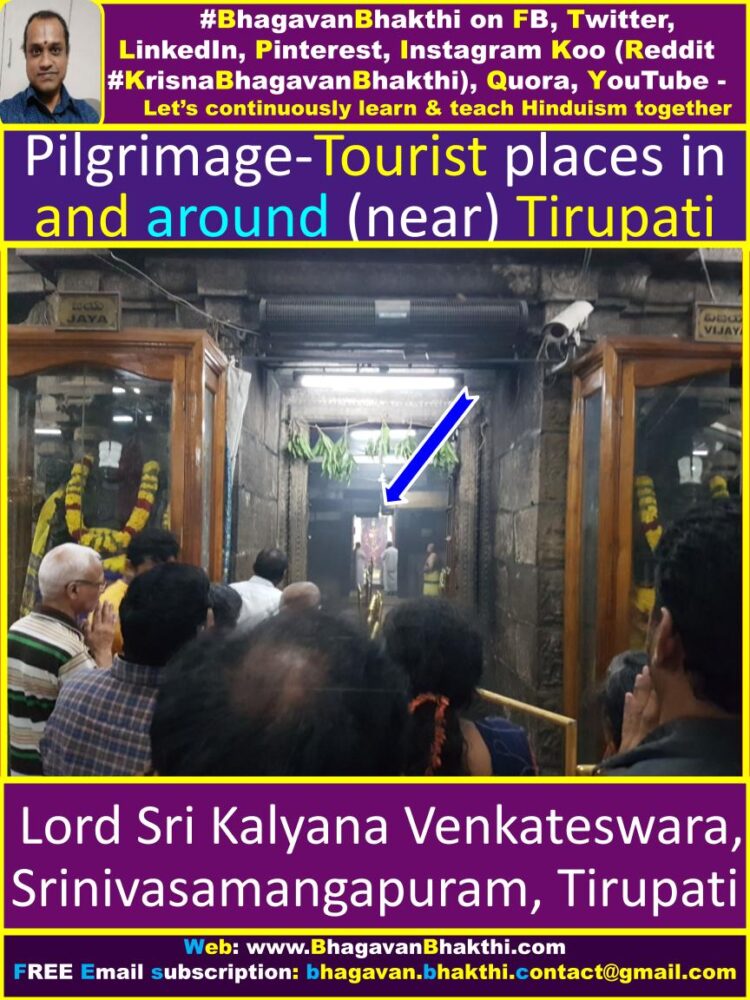
Chandragiri fort, Tirupati : Chandragiri is the south-west entrance to Tirupati for vehicles coming from Bengaluru, Kerala and Tamil Nadu. Kalyana Venkateswara Temple, Srinivasamangapura is located next to Chandragiri, through which stone footpaths known as Srivari Mettu are available to reach Tirumala on foot.
Chandragiri is now famous for the historic fort built in the 11th century and the royal mahal (palace) inside. The fort is surrounded by eight ruined temples of both Shaiva and Vaishnava traditions, Raja Mahal, Rani Mahal and other ruined structures.
The Raja Mahal Palace is now an archaeological museum. The fort and palace are under the care of the Archaeological Survey of India. The palace is open to the public, but the fort is closed. The palace is an example of Indo-Sarsen architecture of the Vijayanagara period.
The palace was built using stone, brick, lime mortar and no wood and of course no cement. The crown towers represent elements of Hindu architecture.
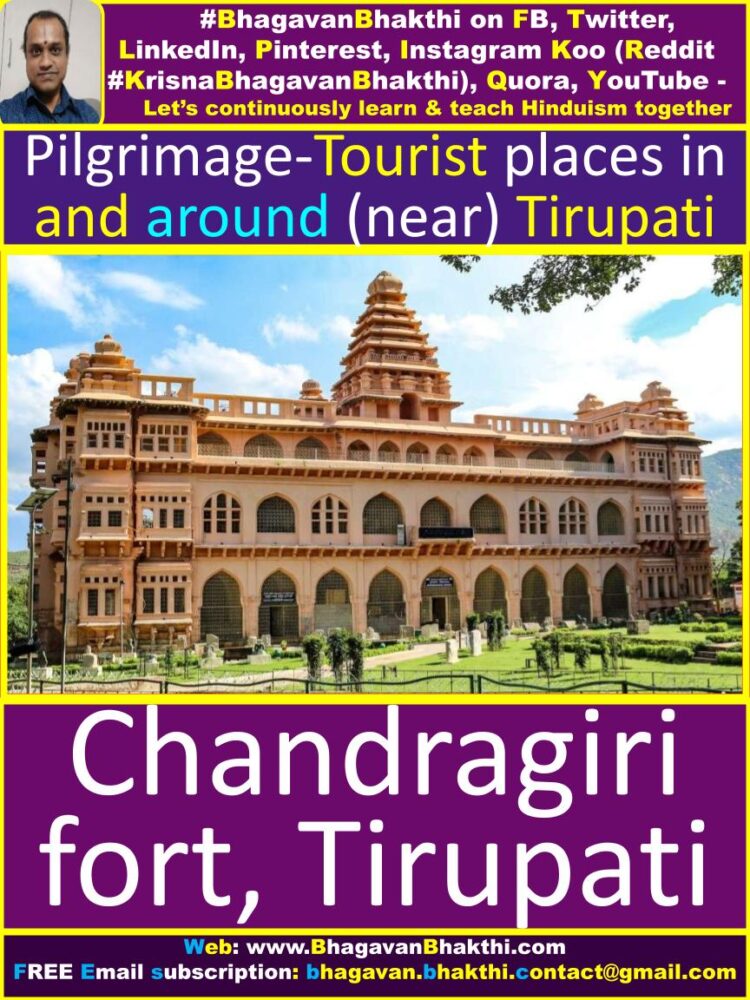
Srikalahasti (Srikalahasteeswara) Temple, Tirupati : Srikalahasti Temple is located in Srikalahasti town in Tirupati district of Andhra Pradesh state, India.
It is one of the most famous Lord Shiva temples and is said to be the place where Kannappa was ready to offer both his eyes to stop the blood flowing from the Linga before Shiva stopped him.
Located 36 km from Tirupati, Srikalahasti or Srikalahasteshwara Temple is famous for its Vayu Linga (Wind Linga), one of the five shrines representing wind. This temple is also considered Rahu-Ketu Kshetra and Dakshina Kailasam.
In primeval times, Vayu, the god of air, performed austerities for thousands of years at the Karpoora (camphor) linga. Lord Shiva, pleased with Vayu’s penance, appeared before him and granted him three boons.

Vayu is blessed to present everywhere in the world in the form of air and wants to be an integral part of every living being in the form of air. Further, the worshiped linga Vayu was named Vayulinga after him and declared to be worshiped by various beings.
Another legend narrates that Goddess Sri Parvati Devi, consort of Lord Shiva, was cursed him to renounce her divine form and assume human form. As an atonement, Goddess Sri Parvati Devi performed penance at Srikalahasti to please Lord Shiva.
Lord Shiva gave Goddess Sri Parvati Devi a heavenly body hundred times better than her previous divine form. Goddess Sri Parvati Devi is worshiped in the temple as Shiva-Gnanam or Gnana Prasunamba or Gnana Prasunambika Devi.

Srivari Padalu (Lotus feet), Tirupati : When Lord Sri Vishnu came to Venkatadri from Vaikuntha, he placed his first foot here, the second foot near the stone tower and the third foot in today’s Anandanilayam (a gold-plated tower, that is, at the sanctum sanctorum of the Tirumala Venkateswara Temple).
Puranas say that Lord Venkateswara is worshiped not only by ordinary devotees, but also by deities like Lord Brahma and Lord Shiva.
When Lord Brahma and Shiva come to Venkatachalam (Tirumala), they directly approach Lord Sri Venkateswara’s feet and bow down to offer obeisance to the lotus feet of Lord Sri Venkateswara.
Lord Sri Venkateswara’s golden lotus feet are always full of flowers and Tulasi. Lord Sri Srinivasa (Venkateswara) golden feet without any flowers and Tulsi can be seen only in the morning at the time of Suprabhata Darshan.
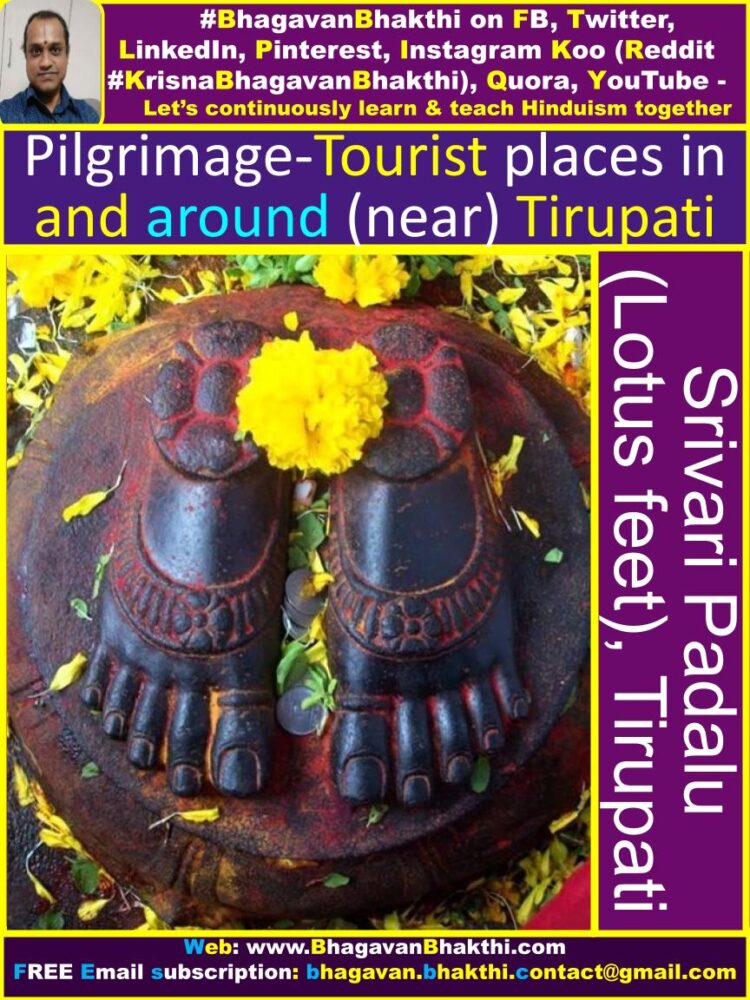
Kodandarama (Kodandaramaswamy) Temple, Tirupati : Sri Kodandaramaswamy Temple (Lord Sri Rama) is one of the famous temples in the holy city of Tirupati in Tirupati district of Andhra Pradesh, India after Tirumala Venkateswara Temple.
The temple is dedicated to the Supreme Lord Sri Rama, an incarnation of Lord Sri Vishnu along with Goddess Sri Sita Devi and Lakshmana. The temple also has a sub-shrine of Anjaneya (Hanuman), the mount and greatest devotee of Lord Sri Rama.
As per Varaha Purana, during the Treta Yuga, Lord Sri Rama stayed here along with Goddess Sri Sita Devi and Lakshmana after returning from Lankapuri (Lanka).
Rama Navami is celebrated with great pomp in this temple which includes Hanuman Vahana Seva on the day of Sri Rama Navami followed by ‘Sri Sita Rama Kalyanam’ on Dashami and ‘Sri Rama Pattabhishek Mahotsavam’ on Ekadashi.
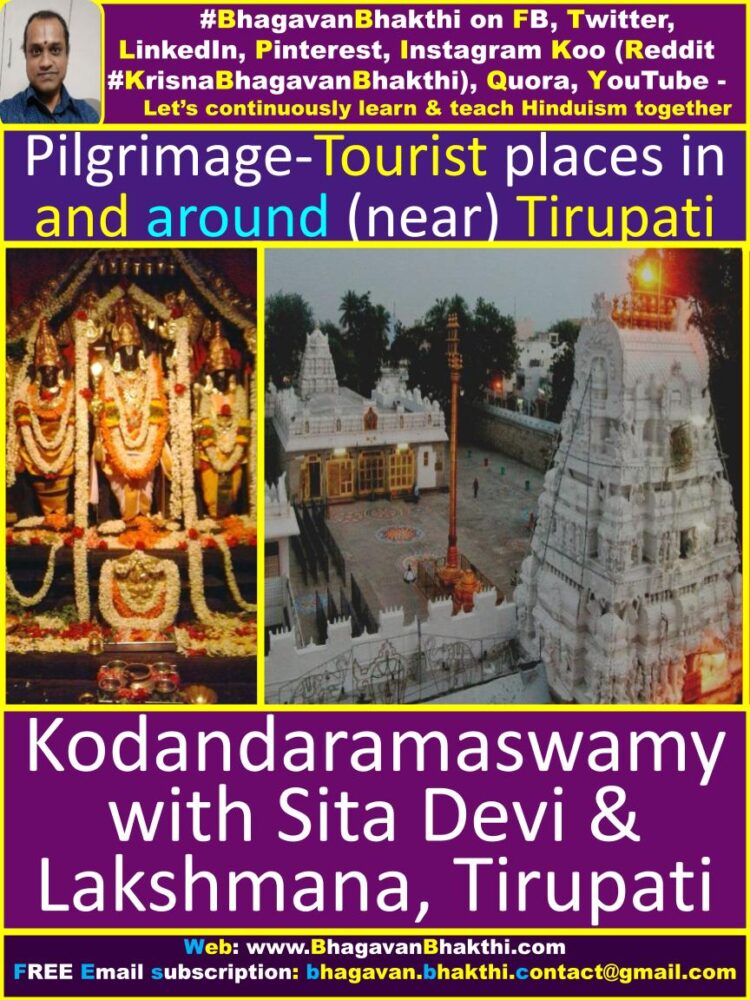
Tumburu (Tumbura) Theertham : ‘Tumbura (Tumburu) Theertham’ is one of the holy shrines of Tirumala Kshetra. Local legend (Sthala Purana) says that taking a bath in this tirtham (pond) gets rid of all sins and attains moksha.
Tumbura theertham is located 16 km north of Venkateswara Swamy Temple in Tirumala. Even today there are evidences of Lord Venkateswara’s devotee Tarigonda Vengamamba spending his last days in meditation of Lord Venkateswara this theertha named Tumburu (Tumbura).
Once upon a time, a Gandharva named ‘Tumburudu’ prayed to the sages to let him know the way to attain salvation. Then they asked him to take bath in this tirtha in Tirumala, the Gandharva who did so and got salvation.
As ‘Tumburu’ is the tirtha where he got salvation, this tirtha got its name ‘Tumburu tirtha’. It is for this reason that some of the devotees who go to Tirumala reach this temple and take bath in this theertham.

Jabali Theertham : Jabali is the most holy divine place that shines as Swayambhu according to the wish of Maharshi Jabali. Sage Jabali lived in a holy place called Tirumala and practiced penance. Presently the place near Tirupati where Sage Jabali lived is known as “Jabali Theertham”.
Jabali Theertham is situated on top of Tirumala hill, five kilometers away from Lord Sri Venkateswara Swamy sannidhi. In Skanda Purana, ‘Venkatachala Mahatmya’ mentions this Kshetra. It is situated on Tirumala Hill on the way to Papavinasanam.

Akasha Ganga Theertham : Akasha Ganga Theertham is in Tirumala. It is about 3 kms north of Lord Venkateswara Temple. It is believed that Anjanadevi performed penance here and carried Anjaneya (Hanuman) in her womb.
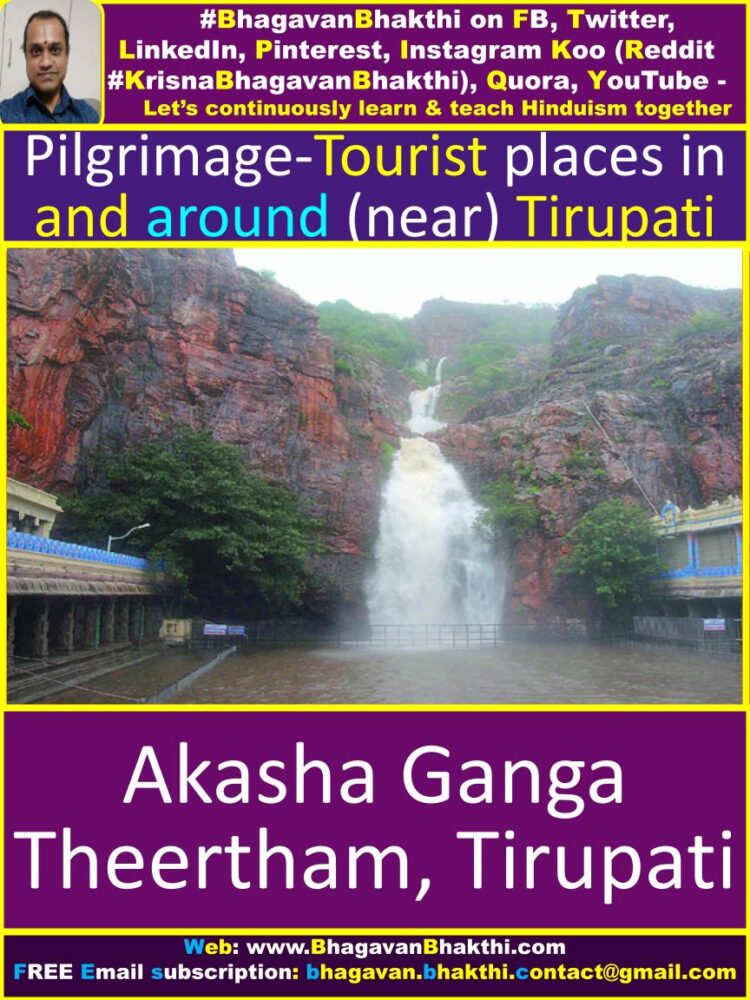
Silathoranam (Shilatoranam), Tirupati : One kilometer north of the main temple of Lord Sri Venkateswara Swamy in Tirumala, there is a natural ready-made rock arch at Chakratirtham. The dimensions of this rock arch are 8 meters (26.2 ft) wide and 3 meters (9.8 ft) high.
The estimated geological age of the stone arches is 2.5 million years. The arch formation is due to the erosion of stream action that withstands severe weather and the torque of nature.
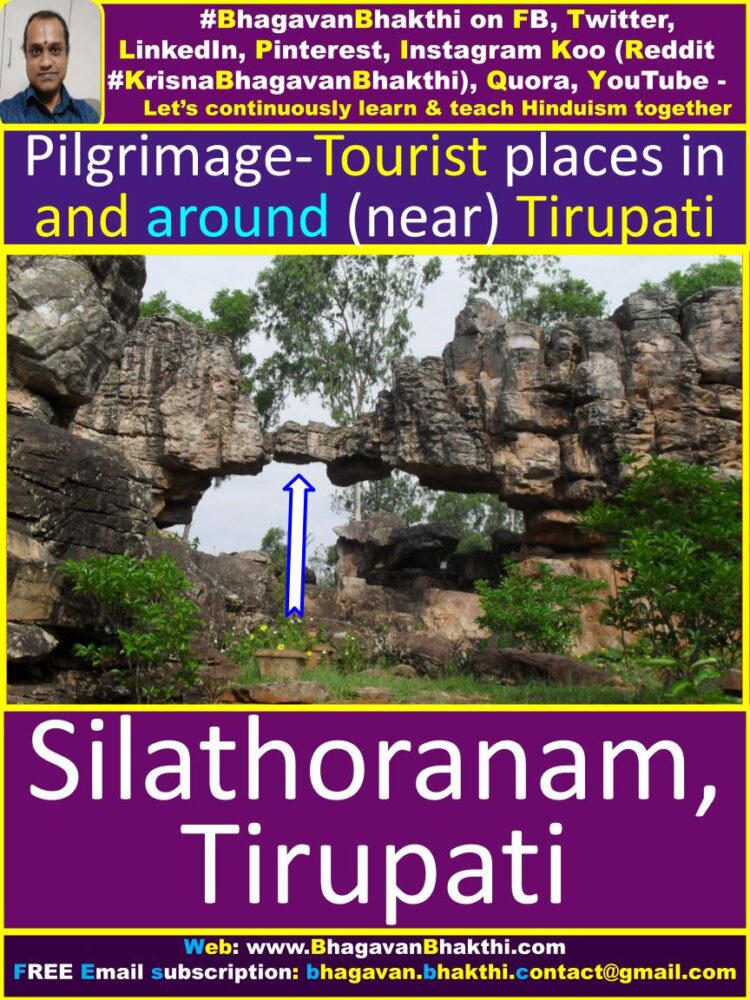
Papavinasanam theertham (waterfalls), Tirupati : Papavimshanam is a holy waterfall. After the construction of Kalyani Dam, Tirumala Devasthan made an artificial waterfall. Bathing in this water is believed to reveal sins and sanctify a person to worship God.
Millions of pilgrims visit here, bathe before having a darshan of the deity of Tirumala Lord Venkateswara. On the other side of the dam are about seven theerthams, which will be opened to the public on Phalguna masam, Purnima, the full moon day.

Srivari (Sri Venkateshvara) Museum, Tirupati : The Tirumala Tirupati Devasthanams (TTD) have established Sri Venkateswara Museums, one at Tirumala and the other at Tirupati. It has an amazing collection of Tirupati Tirumala temple architecture and historical artefacts like ancient weapons, puja paraphernalia and deities.
It has a comprehensive photo gallery that gives a unique insight into the culture and traditions of the Tirupati Tirumala region. It also has a meditation center too. In 1988-89 the Archaeological Survey of India established an archaeological museum at Chandragiri Fort in Chandragiri.
It exhibits a rich collection of stone and metal sculptures of Hindu deities and other cultural relics retrieved from other historical places like Gudimallam, Gandikota and Yaganti. It also contains galleries for medieval weapons such as swords and daggers, coins and paper documents.
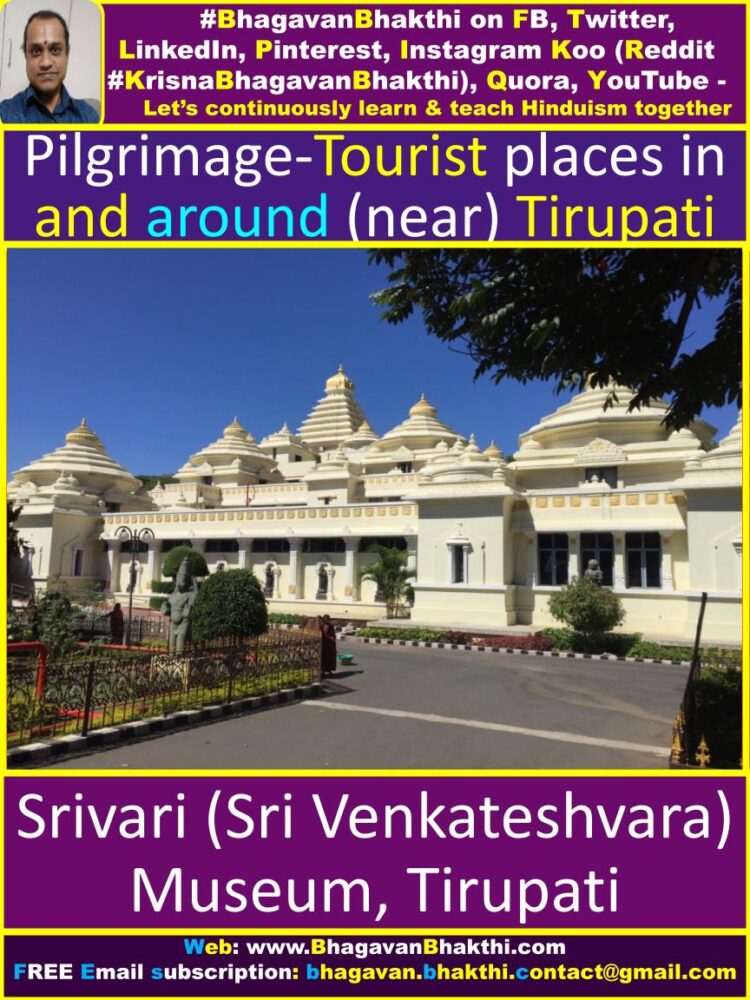
Now, let us look at the pilgrimage places which are located near Tirupati (Tirumala) (Venkatachalam) mountain as per our Hindu Puranas.
List of pilgrimage places near Tirupati (Tirumala) (Venkatachalam hill) as per Hindu Puranas (Texts) (Scriptures) are as given below:
Krishna Teertham | Swami Pushkarini | Papavinashini | Pandu Teertham | Kumara Dharika | Teertham | Tumbu Teertham | Akashaganga Teertham
Krishna Teertham: Sutaji narrated a tale to all the assembled sages:
During ancient times, a brahmin named Ramakrishna did an austere penance at Venkatachalam hill (Today’s Tirupati).

He remained immobile during the entire course of his penance resulting into the development of mole hills all over his body. Indra was scarred by Ramakrishna’s penance and caused a heavy downpour for a week.
All the mole hills were washed away from Ramakrishna’s body. Lord Srinivasa became pleased and appeared before him. He blessed Ramakrishna by saying:
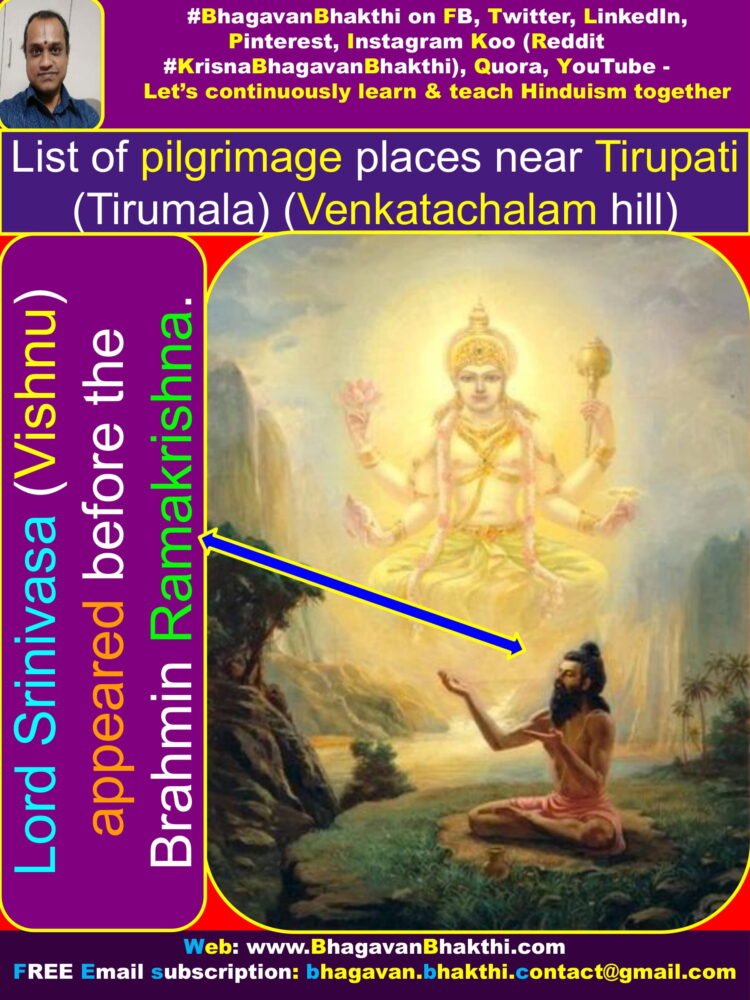
‘This holy place, where you have performed a great penance will be named after you as Krishna teertham. Anybody who makes a pilgrimage to this place will be liberated from all the sins.’
Eulogizing Lord Venkateswara, Sutaji says: ‘A man, who has the good fortune of seeing the divine appearance of Lord Srinivasa even for a moment, attains salvation (Moksha) (The abode of Lord Vishnu – A place in Vaikuntha).’
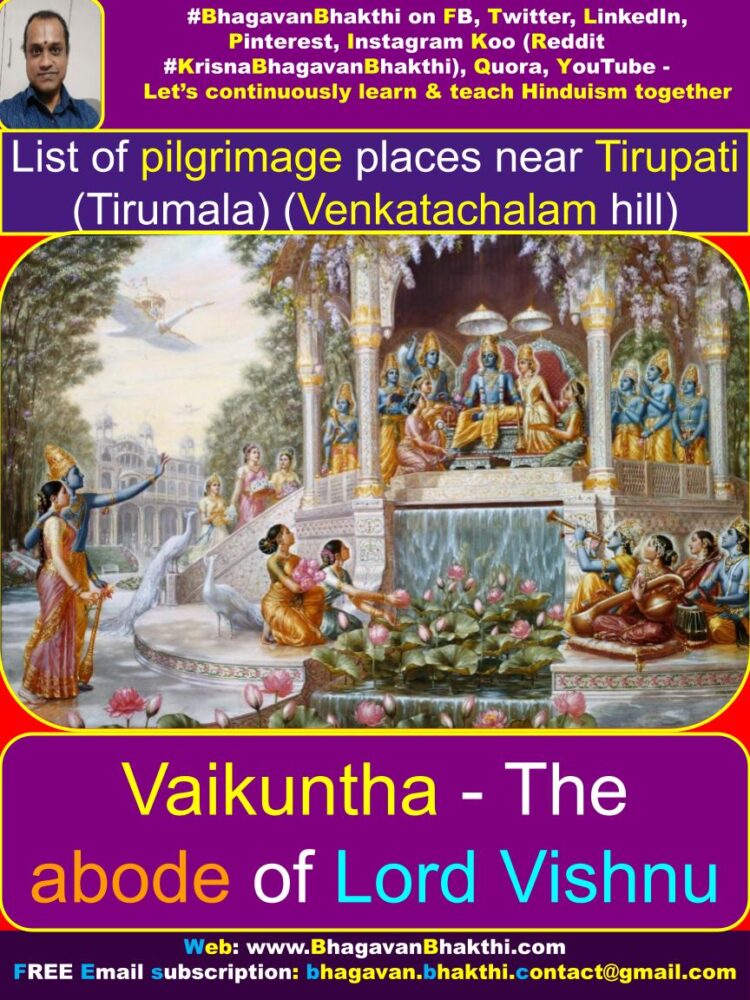
FEW OTHER PILGRIMAGE PLACES ON VENKATACHALAM MOUNTAIN : All the sages then requested Sutaji to tell about some other places of pilgrimage situated on Venkatachalam mountain.
Sutaji replied: ‘There are about one hundred and eight holy places situated on Venkatachalam mountain.’
Among all these holy places, six are considered to be capable of bestowing salvation: Swami Pushkarini | Akasha Ganga | Papavinashini | Pandu Teertham | Kumara dharika | Teertham | Tumbu Teertham
ANJANA’S PENANCE AT AKASHAGANGA TEERTHAM : Describing how Lord Vayudeva Deva had once assured Anjana and Kesari that he would take birth as her son, Sutaji told the sages:

‘Anjana, being issue less even after a long married life, decided to do penance in order to beget a son.’
Sage Matanga advised her to go to Akashaganga Teertham where her wishes would get fulfilled. Sage Matanga also described the Akashaganga Teertham geographical location: At a distance of ten yojanas towards south is situated Dhanachala mountain, which is believed to be the abode of Lord Narasimha.
Brahma Teertham lies in its vicinity. At a distance of ten yojanas south of Brahma Teertham, flows river ‘Suvarnamukhari‘. Venkantachalam mountain is situated to the north of this river and the holiest place called Swamipushkarini is situated among its numerous peaks.
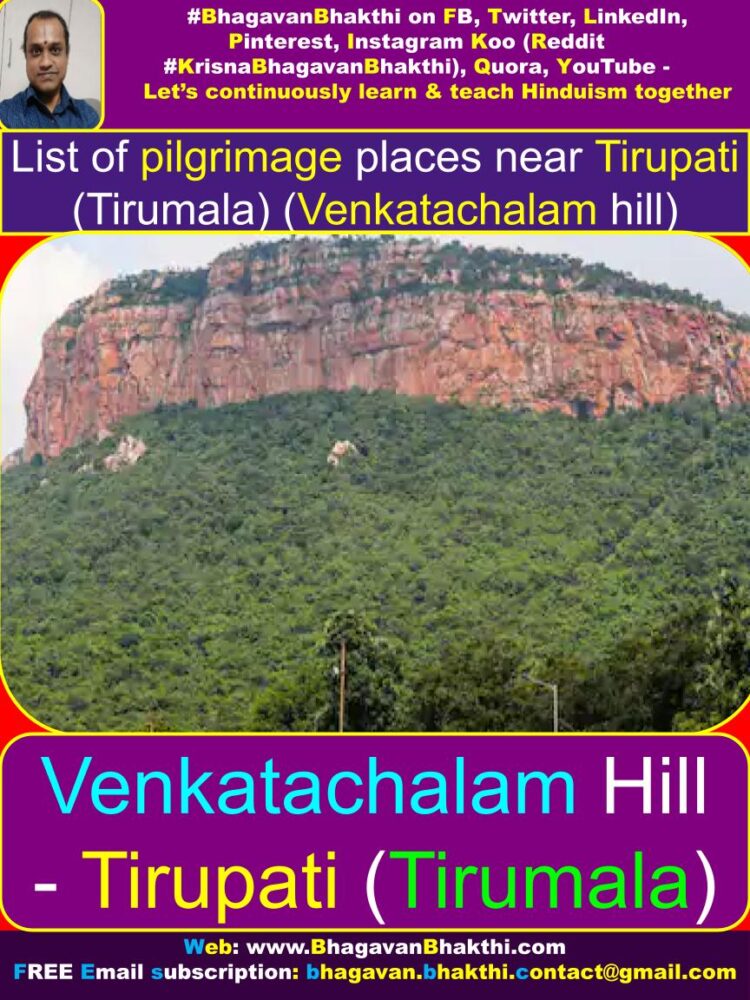
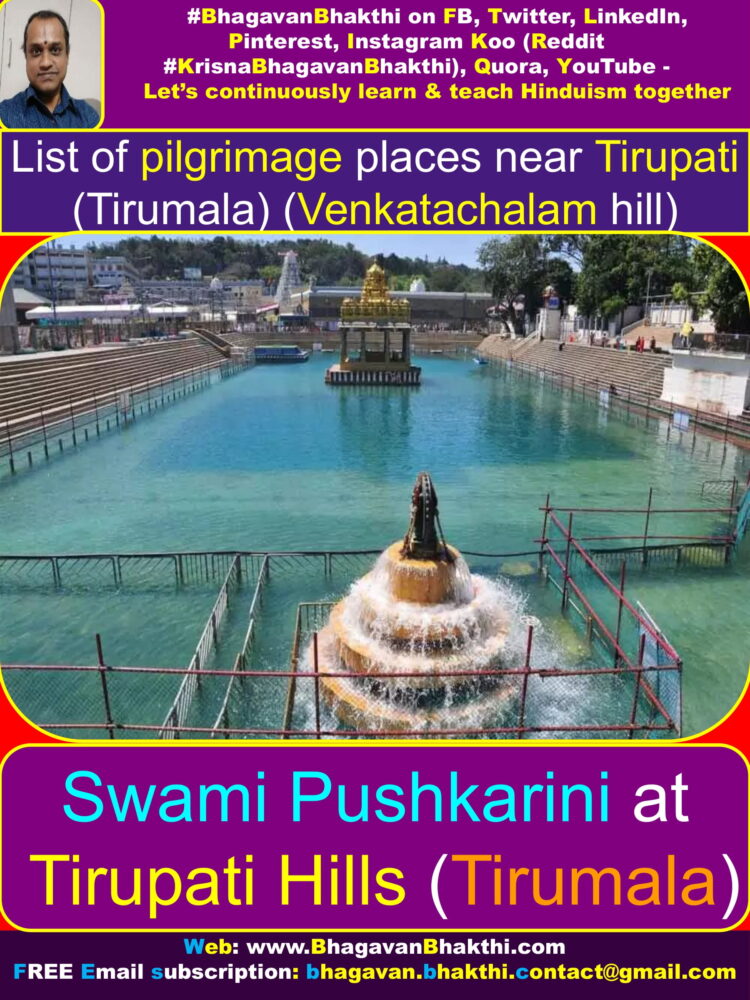
You should visit that place and take a holy dip in its water. After that you should seek the blessings of Lord Varaha Swamy and Lord Venkateswara.
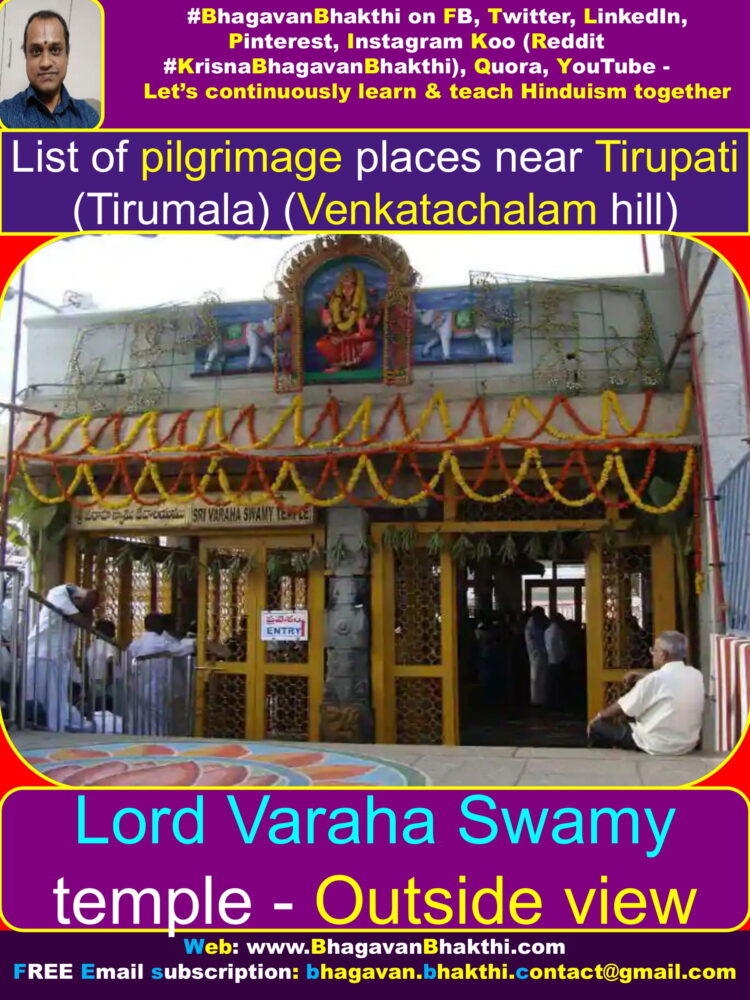
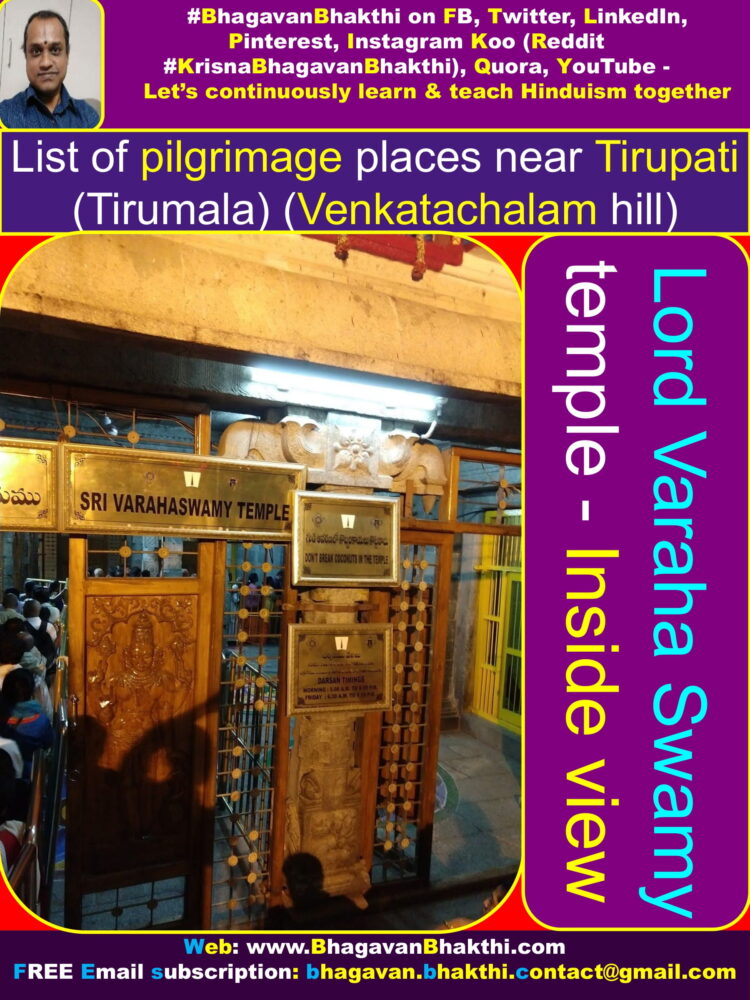

You should then go towards north of Swami teertham and you would reach Akashaganga teertham.’
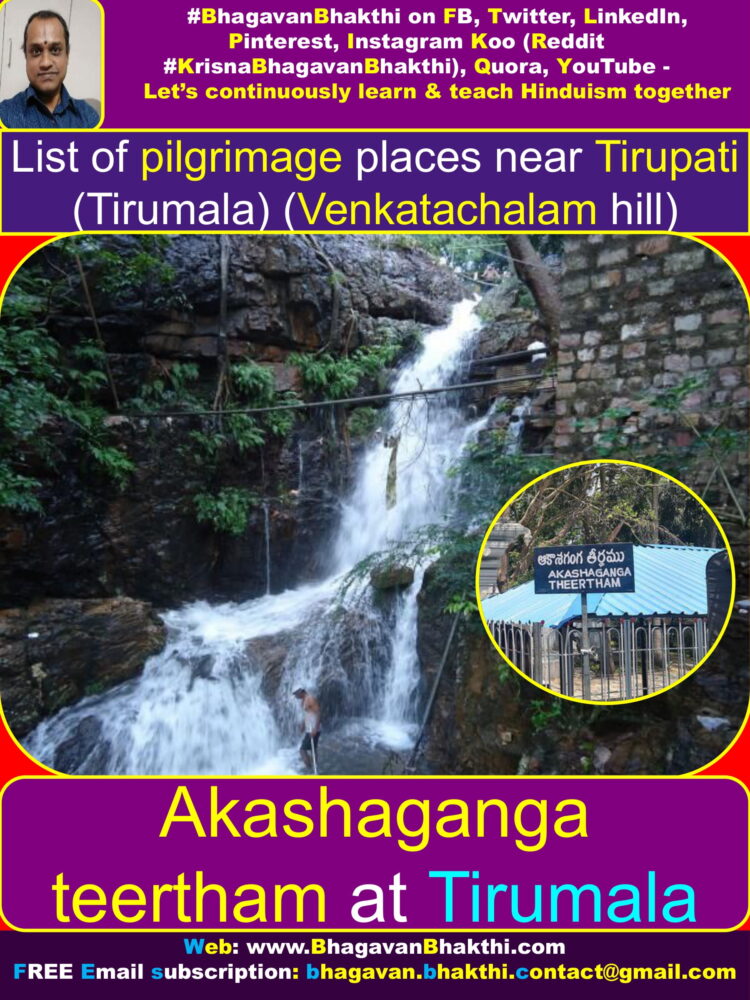
Acting as per Matanga’s instructions, Anjana went to Akashaganga teertham and did her penance. Finally Lord Vayudeva appeared before her and promised to incarnate as Hanuman.

More information will be added to this on regular basis. Please visit this post again and other posts of this website (blog) to get the updated information
To watch videos on #Hinduism #Sanskrit language, SUBSCRIBE to my YouTube channel from this below link:
#BhagavanBhakthi YouTube channel
To know full information about “Pilgrimage places in India“, you can visit this link:
To know full story of “How Lord Srinivasa (Balaji) (Venkateswara) got married with Padmavati Devi“, you can visit this link:
Sri Srinivasa Kalyanam (marriage) full story
To know “Lord Krishna unknown facts and information“, you can visit this link to gather more information:
Lord Krishna unknown facts and information
Dear friends, if you need any clarifications about this post, kindly let me know, I will definitely try to answer all of them.
Also your one LIKE, one COMMENT, One Share, one SUBSCRIPTION is highly important.
This will help to know the quality of this content and also it will be helpful to know if any improvements is required for the content.
If you feel this content is useful to you and has helped you to improve your knowledge, kindly share this with your well-wishers.
Because “SHARING MEANS CARING”.
For receive FREE EMAIL SUBSCRIPTION about #BhagavanBhakthi, you can send an email to [email protected] from your email ID.
NAMASTE!
SRIGURUBHYO NAMAHA
OM NAMO NARAYANAYA
Sri Krishnaarpanamastu